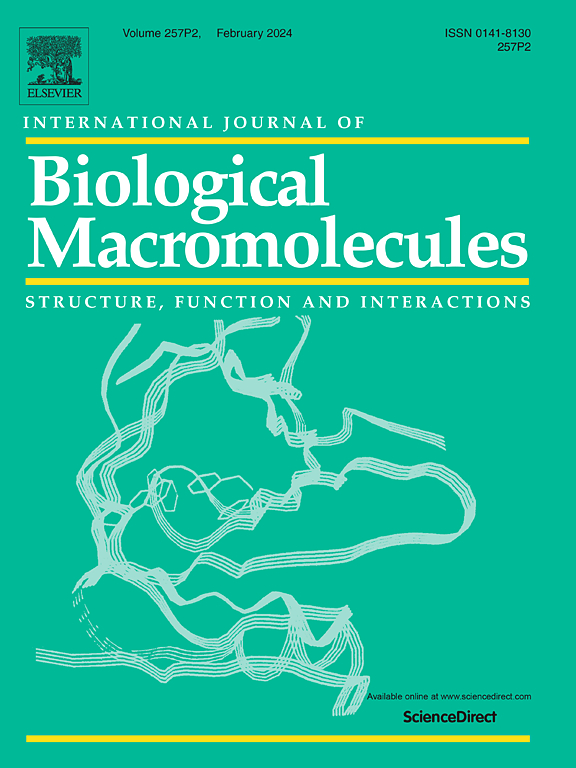Preparation, characterisation, and application of gelatin/sodium carboxymethyl cellulose/peach gum ternary composite microcapsules for encapsulating sweet orange essential oil
IF 7.7
1区 化学
Q1 BIOCHEMISTRY & MOLECULAR BIOLOGY
International Journal of Biological Macromolecules
Pub Date : 2025-01-22
DOI:10.1016/j.ijbiomac.2025.140218
引用次数: 0
Abstract
This study successfully developed a gelatin-sodium carboxymethyl cellulose-peach gum composite microcapsule system using the complex coacervation method. Optimal preparation conditions were determined by turbidity, complex condensate yield and encapsulation efficiency: the ratio of gelatin to sodium carboxymethyl cellulose was 7:1, the ratio of gelatin/sodium carboxymethyl cellulose to peach gum was 4:1, and the pH value was 4.2. The morphology of the system was evaluated using scanning electron microscopy and laser confocal microscopy. Structural properties and viscoelasticity were analyzed through Fourier-transform infrared spectroscopy, Raman spectroscopy, and rheology. Results indicated that adding peach gum enhanced the system's structural stability and solid behavior. Thermogravimetric analysis, differential scanning calorimetry, swelling, release, antioxidant, and antibacterial experiments confirmed that the addition of peach gum increased the thermal decomposition temperature of the microcapsule system to 246 °C, enhanced the sustained release capacity, and improved both the antioxidant effects and antibacterial properties. The highest lipid antioxidant value was 1.1 mg MDA/kg, while the total bacterial count reached a maximum of 5.3 log CFU/g, both of which remained below the threshold of food spoilage, thereby confirming the role of the gelatin-carboxymethyl cellulose sodium-peach gum composite system in meat preservation. The gelatin-sodium carboxymethyl cellulose-peach gum composite system's excellent sustained-release capacity, antioxidant effect, and the antibacterial properties of the gelatin-sodium carboxymethyl cellulose-peach gum composite system could provide a new carrier for the application of active substances in the food sector.
甜橙精油凝胶/羧甲基纤维素钠/桃胶三元复合微胶囊的制备、表征及应用
本研究采用复凝聚法制备了明胶-羧甲基纤维素钠-桃胶复合微胶囊体系。通过浊度、络合物收率和包封效率确定最佳制备条件:明胶与羧甲基纤维素钠的比例为7:1,明胶/羧甲基纤维素钠与桃胶的比例为4:1,pH值为4.2。利用扫描电子显微镜和激光共聚焦显微镜对该体系的形貌进行了评价。通过傅里叶变换红外光谱、拉曼光谱和流变学分析了结构性能和粘弹性。结果表明,桃胶的加入提高了体系的结构稳定性和固体性能。热重分析、差示扫描量热、溶胀、释放、抗氧化和抗菌实验证实,桃胶的加入使微胶囊体系的热分解温度提高到246 ℃,缓释能力增强,抗氧化和抗菌性能均有提高。脂质抗氧化值最高为1.1 mg MDA/kg,细菌总数最高为5.3 log CFU/g,均低于食品腐败阈值,从而证实了明胶-羧甲基纤维素钠-桃胶复合体系在肉类保鲜中的作用。明胶-羧甲基纤维素钠-桃胶复合体系具有优异的缓释能力、抗氧化作用和抗菌性能,可为活性物质在食品领域的应用提供新的载体。
本文章由计算机程序翻译,如有差异,请以英文原文为准。
求助全文
约1分钟内获得全文
求助全文
来源期刊
CiteScore
13.70
自引率
9.80%
发文量
2728
审稿时长
64 days
期刊介绍:
The International Journal of Biological Macromolecules is a well-established international journal dedicated to research on the chemical and biological aspects of natural macromolecules. Focusing on proteins, macromolecular carbohydrates, glycoproteins, proteoglycans, lignins, biological poly-acids, and nucleic acids, the journal presents the latest findings in molecular structure, properties, biological activities, interactions, modifications, and functional properties. Papers must offer new and novel insights, encompassing related model systems, structural conformational studies, theoretical developments, and analytical techniques. Each paper is required to primarily focus on at least one named biological macromolecule, reflected in the title, abstract, and text.

 求助内容:
求助内容: 应助结果提醒方式:
应助结果提醒方式:


